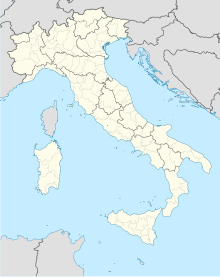The Grotta del Cavallo or Cavallo Cave (Italian:"Cave of the Horse") is a limestone cave in the region of Apulia, Southern Italy, near Nardò 90 km (55.92 mi) south of Taranto. The cave is about 15 m (49 ft) above present sea level. It has a rounded entrance, 5 m (16.40 ft) wide and 2.5 m (8.20 ft) high opening toward the sea. The cave was rediscovered in 1960 and two waves of excavations ensued. The first wave spanning from 1963 to 1966 and the second from 1986 to 2008. The cave was disturbed by looters during the period between the two waves of excavations, damaging the layers corresponding to the Upper Palaeolithic; because of this, the cave entrance is covered by a gate and is closed to the public.[1]
| Grotta del Cavallo | |
|---|---|
| Cavallo Cave | |
 | |
| Location | Apulia, Italy |
| Coordinates | 40°9′18″N 17°57′36″E / 40.15500°N 17.96000°E |
| Geology | limestone |
Archaeology
editStratigraphy
editThe cave contains a rich stratigraphic succession with a depth of 7 m (23 ft), that is deposited on top of an interglacial beach foundation. The most notable section of this sequence covers the Middle Palaeolithic, associated with the Neanderthal Mousterian culture and recently discovered subsequent strata that were associated with the earliest known appearance of Anatomically modern humans in Europe.
Discoveries
editIn 1964 two deciduous molars were discovered in the cave. In 1967 researchers described the teeth as of Neanderthal origin and assumed that the accompanying stone tools and shell bead ornaments were typical of a Neanderthal culture, that was subsequently termed the Uluzzi culture[2][3] as it closely resembles the Châtelperronian. However, the association of the Châtelperronian culture with Homo neanderthalensis is subject of ongoing debate.[4][5] In 2011, a team of researchers led by Stefano Benazzi of the Department of Anthropology at the University of Vienna published a study in the journal Nature which concluded that the teeth are not of Neanderthal origin, but from an early Homo sapiens and date from 45,000 to 43,000 years BP. According to Benazzi these results allow the support of the hypothesis that the Uluzzi culture is not to be attributed to Neanderthals but to modern humans. [6] Although the Human provenance of these teeth is contended, no evidence contradicting this claim has been put forward [3][7] and it has gained some acceptance. However, the attribution of the entire Uluzzi technology to Anatomically Modern European Humans is more contentious.[8]
References
edit- ^ Benazzi, Stefano; Douka, Katerina; Fornai, Cinzia; Bauer, Catherine C.; Kullmer, Ottmar; Svoboda, Jiří; Pap, Ildikó; Mallegni, Francesco; Bayle, Priscilla; Coquerelle, Michael; Condemi, Silvana; Ronchitelli, Annamaria; Harvati, Katerina; Weber, Gerhard W. (2011). "Early dispersal of modern humans in Europe and implications for Neanderthal behaviour". Nature. 479 (7374). Springer Science and Business Media LLC: 525–528. Bibcode:2011Natur.479..525B. doi:10.1038/nature10617. ISSN 0028-0836. PMID 22048311.
- ^ Camps, M.; Chauhan, P. (2009). Sourcebook of Paleolithic Transitions: Methods, Theories, and Interpretations. Humanities, Social Science and Law. Springer New York. p. 385. ISBN 978-0-387-76487-0.
- ^ a b Callaway, Ewen (2 November 2011). "Who were Europe's first humans?". Nature blog. Retrieved 12 November 2015.
- ^ Higham, Thomas; Jacobi, Roger; Julien, Michèle; David, Francine; Basell, Laura; Wood, Rachel; Davies, William; Ramsey, Christopher Bronk (23 November 2010). "Chronology of the Grotte du Renne (France) and implications for the context of ornaments and human remains within the Châtelperronian". Proceedings of the National Academy of Sciences of the United States of America. 107 (47): 20234–20239. doi:10.1073/pnas.1007963107. ISSN 1091-6490. PMC 2996711. PMID 20956292.
- ^ Mellars, Paul (23 November 2010). "Neanderthal symbolism and ornament manufacture: The bursting of a bubble?". Proceedings of the National Academy of Sciences. 107 (47): 20147–20148. Bibcode:2010PNAS..10720147M. doi:10.1073/pnas.1014588107. ISSN 0027-8424. PMC 2996706. PMID 21078972.
- ^ Benazzi, Stefano; Douka, Katerina; Fornai, Cinzia; Bauer, Catherine C.; Kullmer, Ottmar; Svoboda, Jiří; Pap, Ildikó; Mallegni, Francesco; Bayle, Priscilla; Coquerelle, Michael; Condemi, Silvana; Ronchitelli, Annamaria; Harvati, Katerina; Weber, Gerhard W. (2011). "Early dispersal of modern humans in Europe and implications for Neanderthal behaviour". Nature. 479 (7374): 525–528. Bibcode:2011Natur.479..525B. doi:10.1038/nature10617. ISSN 1476-4687. PMID 22048311.
- ^ Zilhao, Joao; Banks, William E.; Gioia, Patrizia (24 July 2015). "COGITO ERGO AGENDA ACTIONIS SUM PHILOSOPHICAL (AND OTHER) TRANSACTIONS ON THE GROTTA DEL CAVALLO, THE SCIENCE OF ARCHEOLOGY, AND THE ETHICS OF PUBLICATION" – via ResearchGate.
- ^ Zilhão, João; Banks, William E.; d’Errico, Francesco; Gioia, Patrizia (8 July 2015). "Analysis of Site Formation and Assemblage Integrity Does Not Support Attribution of the Uluzzian to Modern Humans at Grotta del Cavallo". PLOS ONE. 10 (7): e0131181. Bibcode:2015PLoSO..1031181Z. doi:10.1371/journal.pone.0131181. ISSN 1932-6203. PMC 4495988. PMID 26154139.
